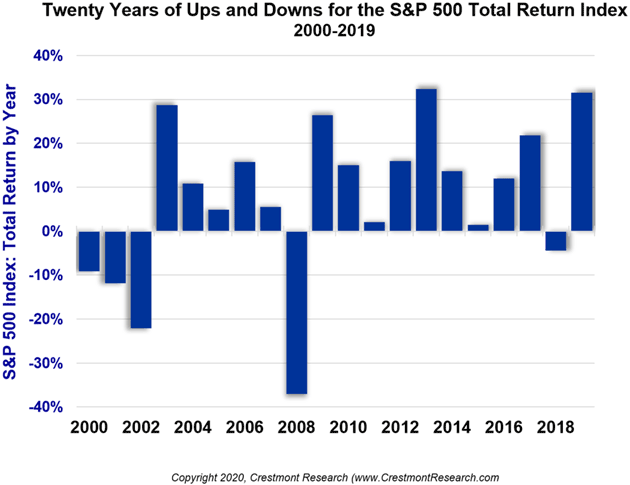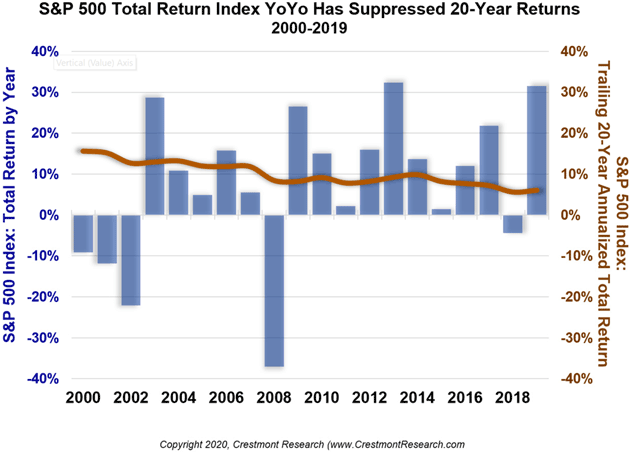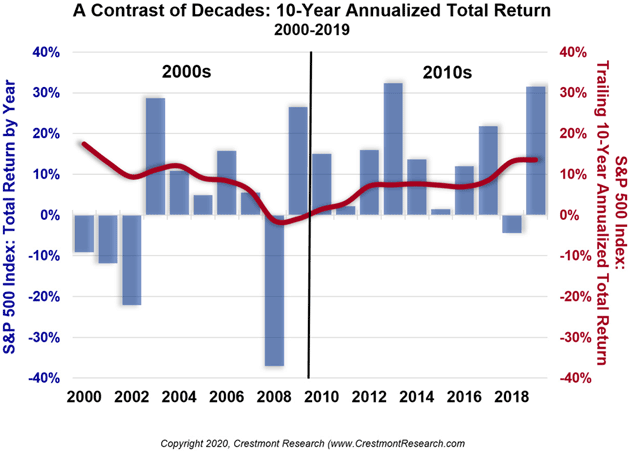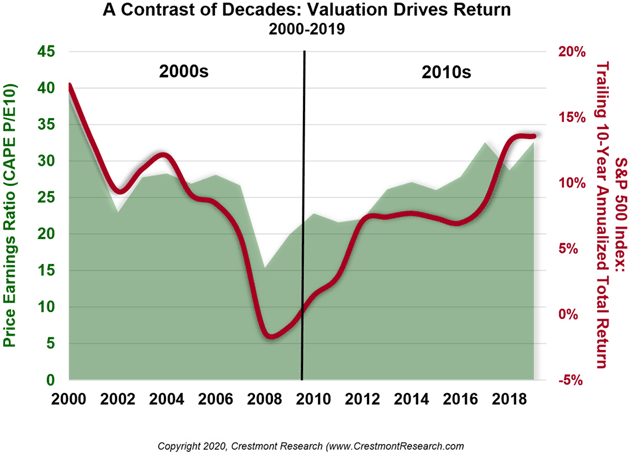by John Mauldin
Regular readers know I often criticize so-called “experts,” usually economists or central bankers whose flawed decisions are punishing the rest of us. I find their expertise is not nearly as reliable as they seem to think.
At the same time, I rely on experts whose judgment I respect. I know they aren’t perfect—usually because they know and disclose their own limitations, and limitations of the data they rely on. I take ideas from many sources, load them in my mental blender and produce what is hopefully a smooth, tasty concoction you read in my letters.
The interesting part, one that often slips my mind, is that sharing these ideas makes many readers consider me an economic expert. Then they hold me responsible for whatever I said, just as I do with central bankers.
They’re absolutely right. We who have large audiences should be accountable for everything we say. In my case that’s not in a legal sense, because these letters aren’t “investment advice” per se, but I still owe readers my best efforts. And—sorry if this shocks anyone—I sometimes get it wrong.
As you will see today, sometimes I get it really, badly, completely wrong. Thankfully, not too often.
That opens an interesting question. Can an expert be both incorrect and valuable? Are we sometimes better off with them than without them?
I think so. And recently someone proved it, even as they highlighted my own mistakes.
Missing the Yen
Earlier this month you read my forecasts for both 2020 and the 2020s (see Part 1, Part 2), in the course of which I re-examined my 2019 outlook. I put a lot of work into those letters, so much so that I completely forgot about the five-year forecast I had published five years ago. I should have reviewed it, too.
(Incidentally, if you ever want to know what I thought at some point in the past, my complete archive back to 2001 is on our website. Visit this page and see the right sidebar. Some of it I wish would disappear, and I like to think my writing has improved over time, but keeping it online is part of my self-accountability.)
But back to that January 2015 five-year forecast. Financial advisor Larry Swedroe recently eviscerated it at the Advisor Perspectives site. A little research revealed he’s written many variations of this same article over the years. Larry believes all forecasts are useless and all forecasters are incompetent. It must be nice to know your conclusion before you start writing. I’m a bit envious.
That said, I gave Larry plenty to criticize. Several of my expected events didn’t happen in the next five years. My main failure was thinking the Japanese Yen would collapse. I didn’t anticipate the Bank of Japan could get away with injecting the vast amounts of stimulus they did.
Let’s backtrack. This was the timeframe I was suggesting when I wrote, “Japan Is a Bug in Search of a Windshield.” I said, correctly, the BOJ would have to monetize significant amounts of Japanese government debt, which was close to 250% of GDP at the time. Their bond market was stretched to the limit. And monetize they did, with a vengeance.
I looked at the more limited quantitative easing we did in the US, and which was still going on in Europe. While our QE exploded asset prices, it didn’t seem to affect the dollar all that much. However, I expected the Bank of Japan would have to do 6X–8X more, relatively speaking, than the US or Europe had. I could find no example in history where such massive intervention by the central bank hadn’t devalued the currency.
Now we know what happened. Let’s just say I didn’t get the same results George Soros and Stan Druckenmiller had betting against the pound decades earlier. Sigh…
Corollary to the yen prediction, the US dollar didn’t strengthen like I thought it would. This let China and other emerging markets avoid “hard landing” scenarios, which might have triggered a US recession and bear market, too.
The sequence of events was plausible at the time, and I still think something much like it would have happened had I been right about the yen. But I wasn’t, and that error led to the others. When you have a bunch of dominoes lined up and the first one doesn’t fall, the others will probably stay upright, too. But they will fall eventually.
Right now, the Federal Reserve is injecting billions into the repo market, which is in turmoil because bond markets are beginning to choke on our huge and growing Treasury debt issuance. They said last year this effort would end in March. My 2020 forecast was that the Fed would continue the program past March. This week they extended it to April. I believe we will see yet another extension or they will quickly resume after a short hiatus, as the market has become addicted to stimulus.
The Wall Street Journal reported last week the Fed is considering a plan to cap long-term Treasury rates by purchasing unlimited amounts of T-bonds. You may recognize that as essentially what the Bank of Japan has been doing. We really are turning Japanese, turning Japanese, I really think so (with apology to The Vapors).
Buy, Hold, Pray
Larry Swedroe uses my mistake, and those of others, to argue that forecasting is futile and no one should pay attention to people like me who do it. Much better, he thinks, to passively allocate your money to index funds and hope for the best. His firm will gladly help you do so, too, for a fee.
I’m not against buy-and-hold indexing. It deserves a place in some portfolios. My main problem with it is that very few people can hold on through the kind of drawdowns that happen every few years. They’ll say they can handle it, and sincerely mean it. You can give them suitability questionnaires, personality profiles, and any other kind of test. You can promise to hold their hand through tough times. But when half their life savings disappears within what seems like a matter of weeks, and they were counting on that money to reach their dreams, almost everyone gives up. They typically will regret it later because they probably sold near the bottom. But their reaction was natural and predictable. I don’t see the value of setting up yourself or your clients for that outcome.
This isn’t just conjecture. We have 25 years of Dalbar’s QAIB (Quantitative Analysis of Investor Behavior) studies. Dalbar looks at mutual fund inflows and outflows to measure actual investor results, given when they bought and sold. They have consistently found the average investor’s return sharply lags those long-term returns the funds advertise. In 2018, when the S&P 500 retreated -4.4%, the average investor lost more than twice as much, -9.4%. This is greed and fear at work.
Buy-and-hold strategies presume you can remove greed and fear from the equation. That is possibly true for a few highly educated, disciplined people. Not most, or anything close to most. Investors are human. They have emotions. Those emotions aren’t going anywhere, nor do we want them to, because they are important to other parts of life.
Active strategies don’t necessarily have better results. For the last 10 years passive investing has clearly outperformed active management, which is why we see investors piling into passive funds.
Passive managers actually disprove their own theory. They assume markets will behave certain ways based on patterns and correlations they can’t know will continue. If forecasting is pointless, then looking at the past and extrapolating it into the future is also pointless. And indeed, those presumed correlations have sometimes fallen apart under stress. We saw it in the 1990s with Long Term Capital Management, and again in the 2008–2009 financial crisis. Asset classes that were supposed to zig when everything else zagged decided they would zag as well, thank you.
Let’s also note, many of the indexes on which index funds are based are hardly passive. Committees decide which stocks to include, and which weighting methodology to follow. So not only is passive investing impractical, it’s often not even passive. For example:
In 1965, the average tenure of companies on the S&P 500 was 33 years. By 1990, it was 20 years. It’s forecast to shrink to 14 years by 2026. About 50 percent of the S&P 500 will be replaced over the next 10 years, if Innosight’s forecasted churn rate holds.
So what they call “passive” is really active management by “expert” committees.
Passive Investing by the Numbers
Clearly, the stock market is hard to predict from year to year. That’s why Larry argues that predictions are pointless and that you should buy and hold. That’s been really good advice for the last 11 years. Passive kicked derrière over active management during that time.
When Larry argues for passive, buy-and-hold strategies, he is talking his book. Passive is what he does, for a fee. I do the same, in private or behind regulated websites. Every money manager does. It’s part of our DNA. Nothing wrong with that.
Let’s look more closely at the book Larry preaches from.
Unless otherwise indicated, the charts below are from my friend Ed Easterling of Crestmont Research, who was just named the Benton County, Oregon’s timber farmer of the year. I have been there and it is a truly fabulous place with 150-foot-tall Douglas firs. He also runs cattle for monthly income—a far cry from his big hedge fund days. But Ed still offers some of the best data and analysis.
This first chart is about the ups and downs for the last 20 years from the S&P 500, ending in 2019.

Just for grins and giggles, here’s a chart going all the way back to 1928. A tad more volatile.

Source: Macrotrends
The next chart shows the past 20 years, which despite good periods, trended toward lower long-term returns…

That is because the past 20 years reflect contrasting decades… a poor start, followed by great post-recession returns, as we see in the next chart. Your buy-and-hold return for the first 10 years was negative, even before inflation and management fees. In real terms, with fees, knock off another 2–3%. That was an ugly decade. But since the Great Recession, it’s been nothing but rainbows and ponies.

Why such a contrast? Because starting valuations drive long-term returns, something Ed and I have jointly written about at least a dozen times. From currently elevated levels, with P/E at historic highs second only to 2000, the next decade will probably be more like the 2000s than the 2010s. Or at least, that’s what 100 years of stock market history suggests.

Here are some relevant questions for those who believe buy-and-hold is all you need:
- Buy-and-hold worked for the last 10 years. Do your clients have 10 years from now?
- We just ended the first decade in US history without a recession, and thus no significant bear market. Do you think that is likely to continue through the 2020s? What if we have two recessions in the 2020s? Are you prepared to hold through a decade of zero or negative returns?
- We are now clearly in the top 10% of historical P/E valuations, when 10-year long-term returns historically have been the lowest on record. On an inflation-adjusted basis, you can actually have negative returns for 20 years. It took 26 years to get back to breakeven from the bear market that began in 1966.
- We don’t know the future. I get that. But I also know that every time somebody like Greenspan or Bernanke says we are in a new era, it turns out not to be the case. P/E ratios matter. Have you shown your clients what happens at the beginning of bull and bear markets in terms of P/E ratios? Are you telling them lower returns over the next 10 years is a real possibility based on history? Just asking…
Floating Aimlessly
Another irony is that Swedroe published his article on Advisor Perspectives, a site that frequently promotes exactly the kind of forecasts (including mine) Swedroe says are useless. I’m not sure why he would want to be in that company.
Even stranger, Swedroe doesn’t just argue forecasting is futile; he questions the value of expertise generally. He cites the example of a physician stating he knows exactly what is wrong and what to do. That’s probably not a good sign but it’s also a straw man.
I’ve been to many doctors in my life. They examine, diagnose, and treat as well as they can based on what they know, limited though it may be. I am still alive and (knock on wood) healthy for my age. That might not be the case if doctors said, “I can’t be sure what is wrong and anything I do might make you worse. Just go home to bed.” I want their expertise and I’m better for it.
No economic forecaster I have ever seen, save a few obvious crackpots, claims certainty. We try to offer insight that helps investors understand what they are doing and why. We try to point out the extraordinary difficulty in predicting the future.
I said this in the opening to my 2019 forecast letter.
We’re all blasted with too much information and it’s easy to get overwhelmed. I find that having a framework helps organize my thoughts. Of course, you have to be flexible and modify the framework when it no longer fits (if the facts change, etc.). But that’s better than floating aimlessly, at least to me.
I wasn’t thinking of it at the time, but “floating aimlessly” is a good way to describe passive investing. You can’t aim if you have no target, or have no idea where the target is. You just float and hope you find it before something bad happens to you.
In the real world, my managed portfolios are fairly bullish—as they should be. But they are diversified and hedged and in some cases can go to cash. We certainly can’t pick market tops and bottoms, but we can avoid the worst of bear markets and enjoy the power of bull markets. Accredited investors who have more options (thanks to the US government’s “protection” of small investors), there are opportunities to enjoy market-like returns with significantly less volatility. (Yes, that is me talking my book.)
So let me make a 10-year forecast that may come back and bite me. I think we see a recession in the early part of the 2020s, and I expect an extraordinarily volatile end of the decade, where another Great Recession is quite possible. If so, total returns will look more like the 2000s rather than the 2010s for buy-and-hold investors.
Bull markets simply don’t begin at valuation levels like we have today. That doesn’t mean you shouldn’t be invested; there are lots of opportunities besides US and world stock markets. But I think the mad rush we’ve seen into passive investing will turn out very badly.
Boomers who are near or in retirement should be very conservative and investing in buy-and-hold large-cap stocks at today’s valuations is the opposite of conservative. It is simply bad advice to suggest they do so. Retirement savings should focus on income and capital preservation.
In my best Dirty Harry imitation, a final question for buy-and-hold advocates. Do you feel lucky? You think the 2020s will look like the 2010s? Are you sure we won’t have another decade like the 2000s? Are you really prepared for a 20-year cycle? Are your clients?
Hope is generally a bad strategy. People often say I am bearish, or a perma-bear. That is so not true. I am cautiously optimistic. 2019 was a stellar year, 2018 not so much. I have no idea what this year will bring so I look for strategies that offer opportunity no matter what happens. Cautious optimism rules. I am bullish on humanity and worried about governments and central banks. I see opportunities everywhere, but they are rifle shots.
Buy-and-hold ruled for the last 10 years. I think the 2020s will see the return of active management. Let’s bring this letter out and look back in 10 years.
Dallas and New York
Shane and I fly to Dallas/Frisco next Wednesday. I have meetings and Shane will be getting her last rental homes ready for sale. Sometime at the end of February I will have to be in New York City. Otherwise, I’m trying to stay home, write, and think.
I’m spending a great deal of time finalizing the schedule for the Strategic Investment Conference at the Scottsdale Phoenician, May 11–14. This will be our 16th conference, and according to our many repeat attendees, each has been better than the last. I think this will continue the tradition. This year we’ve reduced the number of seats by almost 40% because long-time attendees asked us to make the conference smaller. We listened. So if you want to come, look for your invitation in the next week or so and don’t procrastinate. Sign up as soon as you can. You really want to be in the room…
And with that I will hit the send button. You have a great week and don’t go passively into that good night, or the future of the 2020s. There is too much opportunity to miss…
Your not passively watching the world go by analyst,
John Mauldin